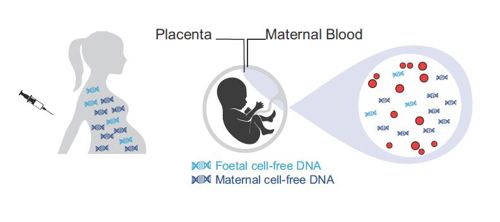Panorama Prenatal Screen
WHAT IS NIPT?
Non-invasive prenatal testing (NIPT) uses a blood sample from the mother to analyse DNA from the baby that has crossed into the mother's bloodstream for certain chromosome conditions that could affect your baby's health.
NIPT:
- Screens for genetic abnormalities such as Down syndrome
- Can identify your baby's gender (optional)
- Provides substantially fewer incorrect results than maternal serum screening or other prenatal blood tests
- Can be done as early as nine weeks into your pregnancy
- Poses no additional risk to your baby
WHAT DOES PANORAMA SCREEN FOR?
Singleton pregnancies
- Trisomy 21 (Down syndrome)
- Trisomy 18 (Edwards syndrome)
- Trisomy 13 (Patau syndrome)
- Triploidy
- Monosomy X (Turner syndrome)
- Microdeletions, including 22q11.2 deletion (optional)
- Gender (optional)
Twin pregnancies
- Identical or fraternal twins
- Trisomy 21 (Down syndrome)
- Trisomy 18 (Edward syndrome)
- Trisomy 13 (Patau syndrome)
- Gender of each twin (optional)
If our screening finds that your twins are identical, Panorama can additionally screen for:
- Monosomy X (Turner syndrome)
- 22q11.2 deletion syndrome (optional)
Egg donor or surrogate pregnancies
- Trisomy 21 (Down syndrome)
- Trisomy 18 (Edwards syndrome)
- Trisomy 13 (Patau syndrome)
WHAT ARE MICRODELETIONS?
A small, missing piece of a chromosome is called a microdeletion. Unlike Down syndrome, which occurs more frequently in mothers who are 35 and older, microdeletions occur in pregnancies at the same rate for mothers of any age. Panorama screens for five microdeletion syndromes associated with serious health problems:
- 22q11.2 deletion (DiGeorge) syndrome
- 1p36 deletion syndrome
- Angelman syndrome
- Prader Willi syndrome
- Cri-du-chat syndrome
IS PANORAMA RIGHT FOR ME?
If you would like to know whether your baby is at risk for certain genetic conditions, Panorama may be the right option for you. The rst step is to talk with your healthcare provider. Some women have a higher chance of their baby being affected with certain chromosome conditions, like Down syndrome, especially if they:
- Are over the age of 35
- Have certain family histories
- Have abnormal ultrasound findings
- Have abnormal blood test results
Panorama is designed for all pregnant women, regardless of age. We accept samples from:
- Naturally-conceived singleton pregnancies
- Twin pregnancies
- Singleton pregnancies that are using an egg donor or surrogate
Unfortunately, we cannot accept samples from women in the following categories:
- Bone marrow transplant recipients
- Pregnancy with a vanishing twin
- Pregnancy using an egg donor or surrogate in which there is more than one foetus
HOW IS PANORAMA DIFFERENT? Other NIPTs cannot tell the difference between mom and baby's DNA. Panorama™ can!
Because of its unique technology, Panorama is the only NIPT that can distinguish between the mom's DNA and the baby's DNA from the placenta. This enables Panorama to be a highly accurate screening test.

FEWER FALSE POSITIVES
Because Panorama analyses the baby's DNA separately, it has a lower false positive and 1,2,3 negative rate than other NIPTs.
HIGHEST FOETAL SEX ACCURACY
Panorama has the highest reported accuracy in determining the foetal sex, and reporting is 1,2,3 optional.
TRIPLOIDY
Panorama is the only NIPT that can detect triploidy, a severe chromosomal abnormality that can result in serious pregnancy 6,7complications if unmonitored.
ZYGOSITY
Panorama is the only NIPT that can determine zygosity (fraternal or identical twins).
WHAT DO PANORAMA RESULTS TELL ME?
Panorama gives you a personalised risk score and tells you if your baby is at high risk or low risk for the conditions it screens for. Like other screening tests, Panorama does not provide a definitive diagnosis of the condition.
WHAT RESULTS MIGHT I GET WITH PANORAMA?
Low Risk:
A Low Risk result indicates that it is unlikely that your baby is affected by one of the conditions on the Panorama panel. Note, however, that a low risk result does not guarantee a healthy pregnancy as Panorama is not a diagnostic test and only screens for certain conditions.
High Risk:
A High Risk result means that there is an increased risk that your baby has the condition, but it is not certain. Invasive testing during the pregnancy, such as amniocentesis (amnio) or chorionic villus sampling (CVS), or testing after the baby is born, can tell you for certain if the baby has the condition. Speak with your healthcare provider about your follow-up options. They may recommend that you speak with a genetic chancellor and/or a maternal-foetal medicine specialist.
No Result:
In a small percentage of cases, Panorama may not be able to obtain sufficient information from your blood sample to determine an accurate result. If this occurs, a second blood sample may be requested.
WHEN CAN I GET PANORAMA?
You can have this test as early as 9 weeks into the pregnancy. For women who weigh more than 90 kg, it is advised to wait until 12 weeks of pregnancy to improve the likelihood of obtaining a result.
WHEN WILL I GET MY PANORAMA RESULTS?
Most results will be returned to your treating doctor or specialist within 7 - 10 working days.
